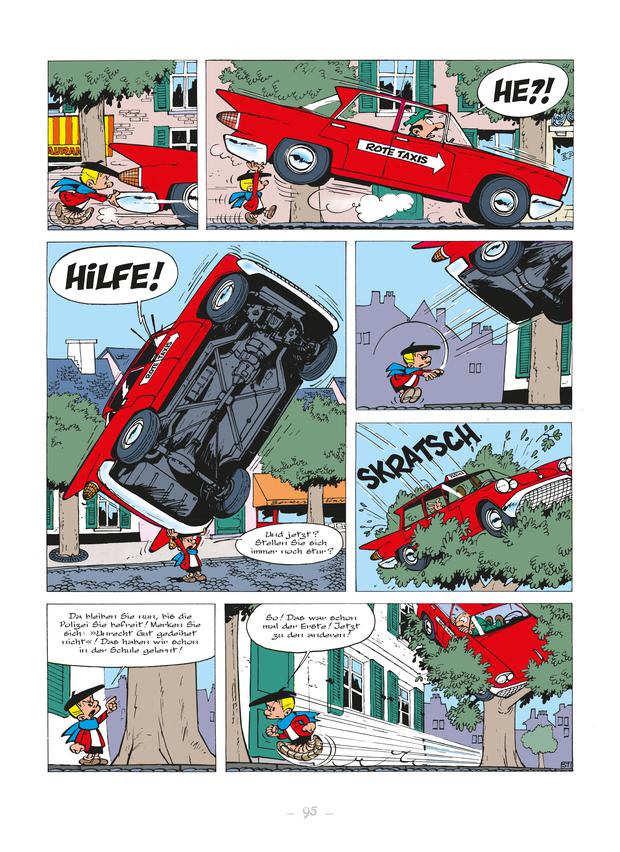He can carry an elephant around with ease, brake a full-speed locomotive and launch a golf ball into space. He doesn’t look like Superman, but like an inconspicuous little boy. His trademarks are a red jacket, shorts, a blue scarf and an oversized beret on the blond hair.
A good 60 years ago, Benni Bärenstark experienced his first comic adventures, and now they can be rediscovered thanks to a new edition (“Benni Bärenstark” complete edition, 2 volumes so far, translation by Max Murmel, Wiebke Besson, Gabriele Montaldi-Seelhorst, toonfish, 224 or 216 pages, €39.95).
With his beret you could mistake him for a Frenchman. However, the boy from the fictional, tranquil small town of Freudenberg is likely to be Belgian. At least its inventor Peyo (aka Pierre Culliford, 1928-92) is a Belgian artist who created the “Smurfs” and developed the idea for the cartoon character Benni Bärenstark in 1960.

André Franquin (“Gaston”, “Marsupilami”, “Spirou and Fantasio”) contributed the basic drafts of the figure, which Peyo modified only slightly.
The starting point for each story is an everyday scene in Freudenberg, before the approximately ten-year-old schoolboy Benni – who is apparently an orphan since no parents disturb the plot – is drawn into an adventure.
Fatal cold
Superheroes have been booming in the USA since the late 1930s and have also caught on with young readers in Europe. Peyo didn’t have a penchant for the genre and wanted his little hero to have enormous powers but otherwise be “just a normal boy”.
Benni is friendly, helpful and unselfishly uses his strength to fight injustice and crime. He also endowed him with a weakness: Benni’s strength dwindles as soon as he catches a cold.
Peyo said in an interview: “When I designed Benni, I quickly thought of giving him an Achilles’ heel. From then on, the reader always worries that Benni might catch a cold.” There is such a point in every plot, which prevents Benni from resolving the conflict too quickly – with crooks or corrupt entrepreneurs, for example.
Aged well
Originally conceived for the newspaper “Le Soir”, the publisher Charles Dupuis liked Benni Bärenstark’s idea so much that he was able to persuade him to publish the series in the magazine “Spirou”. The first three adventures appeared in albums in 1962, there were to be 14 albums in all, which are now being reissued by the Bielefeld toonfish publishing house in a five-volume complete edition with extensive bonus material.

It’s worth rediscovering: the adventures of little Benni have aged surprisingly well. The stories seem timeless and are characterized by original, quirky characters and pointed humor. Almost every adventure also convinces with an exciting, often rapidly told and varied story.
Peyo developed his own clear drawing style that looks a bit tidier compared to André Franquin’s dynamic line. “Benni Bärenstark” is also a good example of the successful division of labor in the Dupuis publishing house, in which the artists supported each other.

In the first two Benni adventures, Peyo was assisted by Will (Willy Maltaite), who was responsible for the background. Since Peyo was soon overwhelmed with drawing several series at the same time, his student François Walthéry (“Natascha”) soon took over the entire drawing work, who soon perfectly matched his master’s style. Marc Wasterlain joined from the sixth album. Peyo mainly reworked the expression of his main characters and gave them the finishing touches.
Peyo worked with experienced authors such as Yvan Delporte or Gos (Daniel Goossens) on most of the plots, so that the stories often escalated into gag fireworks. “Adventure with Uncle Hubert” is a ludicrous parody of the spy films that were popular back then, in 1968.
In the touching story “Circus Bodoni”, Benni becomes a circus attraction because the compassionate boy wants to help a family of artists out of financial difficulties. Peyo has succeeded in creating a particularly multi-faceted character with “Frau Albertine”. One day Benni meets the friendly old lady in Freudenberg. Shortly thereafter, she is observed during robberies and attracts attention with her rude crook language. At some point, Benni realizes that something can’t be right.
It’s just sad that the adults never listen to his explanations of events and can’t imagine that he solved the problem. The adults themselves always prove unable to solve their own problems. With “Benni Bärenstark” Peyo proved to be a gifted narrator of turbulent comics for children, which are also fun for adults due to their wealth of allusions.
To home page
